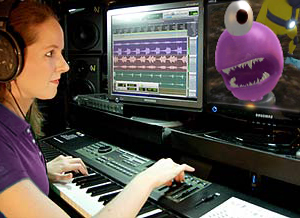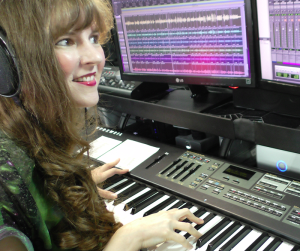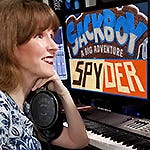
Featured Blog | This community-written post highlights the best of what the game industry has to offer. Read more like it on the Game Developer Blogs or learn how to Submit Your Own Blog Post
Comedic Sound for the Game Music Composer
A discussion of comedic music & sound in games, with advice from pop culture critic Christopher Gates, game sound designer Luca Fusi, and film sound designer Chris Scarabosio. Also: a discussion of my comedic music from The Maw (Twisted Pixel Games).

In this week's blog, I'd like to explore the role that comedy can play in a video game, and how we as game composers can use some of the techniques from comedic sound design to our best advantage. Along the way, we'll be looking at an interesting essay article by pop culture critic Christopher Gates, a presentation by game sound designer Luca Fusi at the December 2015 Vancouver Sound Design Meetup, and an interview with film sound designer Chris Scarabosio.
 I'll also be sharing some of my experiences applying comedic sound design techniques during music composition for the video game The Maw - an award-winning and very funny game that was developed by Twisted Pixel Games.
I'll also be sharing some of my experiences applying comedic sound design techniques during music composition for the video game The Maw - an award-winning and very funny game that was developed by Twisted Pixel Games.
To the left, you can see that I'm working hard to give The Maw its proper dose of comedic wackiness... but more on that later.
First, let's get a broad perspective on the role of comedy in gaming.
Video Game Storytelling: Comedies Need to Let Players in on the Joke
 Christopher Gates (pictured right) is an accomplished pop culture critic who has written for such popular magazines as Maxim, Playboy, Game Rant and many more. In an essay article for the site Sound & Picture, Gates points out the crucial role that audio currently plays in the enjoyment level of a comedic video game. "Next time you boot up a funny video game, try something," Gates writes. "Mute the television, then play for a few minutes. Is the game still making you laugh?"
Christopher Gates (pictured right) is an accomplished pop culture critic who has written for such popular magazines as Maxim, Playboy, Game Rant and many more. In an essay article for the site Sound & Picture, Gates points out the crucial role that audio currently plays in the enjoyment level of a comedic video game. "Next time you boot up a funny video game, try something," Gates writes. "Mute the television, then play for a few minutes. Is the game still making you laugh?"
Drawing attention to such famous video games as Portal, Borderlands 2, Conker's Bad Fur Day, and Sunset Overdrive, Gates points out that most funny video games depend almost entirely on their audio in order to deliver their humor. "Video game comedy is a passive experience, relegated to the soundtrack or between-level cutscenes," Gates observes. "After all, while video game audio might respond to a player’s actions, the player doesn’t control the soundtrack directly. That makes audio an ideal place to put dialogue and humorous asides. It’s easier to control the comedic timing when the player can’t control the pace."
If sound is so crucial in making a game funny, how can we as game composers contribute? Humorous music has a long tradition with many iconic examples we can enjoy and study. For instance, here's an awesome orchestral performance from the 2013 BBC Proms of a medley of composer Scott Bradley's music for the Tom and Jerry cartoons:
Along with the high energy, jovial melodies and arrangements, we'll also notice that this music incorporates a lot of sound design. The sound effects feature an array of car horns, shattering dinner plates, splashing water, gunshots, assorted impact sounds from trash cans and other metal surfaces, popping bubble wrap, and vocal effects that include screaming, barking, snoring, excited grunts and startled yells. Using sound design musically (as it is used in the Tom and Jerry medley) allows a composer to interject some comedic imagery into the texture of a musical score, making the humor more concrete and interconnected with the events of the narrative. So, the question that would logically come up next is... what sounds are funny?
Comedic Sound (The Vancouver Sound Designers Meetup, Dec. 12th 2015)
 We can find some guidance on this topic from a presentation given by technical sound designer Luca Fusi (pictured left) during The Vancouver Sound Designers Meetup last month. Fusi is currently working at PopCap Games, where he has ample opportunities to experiment with comedic sound design. So, what is Fusi's perspective on what makes a sound funny?
We can find some guidance on this topic from a presentation given by technical sound designer Luca Fusi (pictured left) during The Vancouver Sound Designers Meetup last month. Fusi is currently working at PopCap Games, where he has ample opportunities to experiment with comedic sound design. So, what is Fusi's perspective on what makes a sound funny?
"Like all sound design, it sort of depends on the situation," says Fusi. "The thing is that we rely on visuals and expectations and context a whole bunch when we're trying to figure out how to make funny sounds. Context is key," he adds. "Something like, 'Hey this situation seems really dangerous and this guy just shot rainbows and candy out of his gun - that's a total violation of what I would have expected there, and it's also benign and harmless so therefore it's funny." As an example of how thwarted expectation can contribute to humor in a general sense, Fusi showed a gameplay excerpt from the dark sci-fi military shooter Red Faction Armageddon, in which the main character has obtained "Mr. Toots" - a special weapon resembling a unicorn, which is unlike any other weapon to be found in the game. Watch this gameplay video to see Mr. Toots in action:
The sound design for Mr. Toots is especially interesting for our purposes, since it seems to be composed mostly of squeaky toys and flatulence. Mr. Toots' sounds exist in stark contrast to the gritty aural environment of the game, and this helps the sounds to provide lots of comic relief. When the elements of sound design are able to subvert expectations in a surprising but harmless way, they are much better able to evoke laughter from the listener.
 In addition to the element of surprise, humor can also be enhanced by a sense of shared experience and camaraderie. We're more likely to laugh with a friend (pictured right) than we are to laugh alone. Referring to scientific studies on the subject of humor, Fusi offers that "you're thirty times more likely to laugh in the presence of others." With that in mind, Fusi suggests that we should create a sense of human presence in our comedic sound design. "Creating proxies for community, and interaction, and the feeling of other people being there via characterization helps a ton with easing a person into being able to laugh. This is perhaps why," Fusi adds, "things like mouth noises and nonsense speech are so inherently funny by themselves because they are sounds that come out of people." Fusi urges his audience to "always, always get mouth noises in there. They're going to make whatever you're trying to make funnier, guaranteed."
In addition to the element of surprise, humor can also be enhanced by a sense of shared experience and camaraderie. We're more likely to laugh with a friend (pictured right) than we are to laugh alone. Referring to scientific studies on the subject of humor, Fusi offers that "you're thirty times more likely to laugh in the presence of others." With that in mind, Fusi suggests that we should create a sense of human presence in our comedic sound design. "Creating proxies for community, and interaction, and the feeling of other people being there via characterization helps a ton with easing a person into being able to laugh. This is perhaps why," Fusi adds, "things like mouth noises and nonsense speech are so inherently funny by themselves because they are sounds that come out of people." Fusi urges his audience to "always, always get mouth noises in there. They're going to make whatever you're trying to make funnier, guaranteed."
Here's Fusi's entire presentation from last month at the Vancouver Sound Designers Meetup:
Designing Sound: Interview with Chris Scarabosio
 For another perspective, let's take a look at an interesting interview article with Chris Scarabosio (pictured left), who is the supervising sound editor and sound designer at Skywalker Sound. Appearing on the site Designing Sound, this interview explored Scarabosio's experiences creating humorous sound design for projects such as The Minions, Despicable Me 2 and The Grand Budapest Hotel.
For another perspective, let's take a look at an interesting interview article with Chris Scarabosio (pictured left), who is the supervising sound editor and sound designer at Skywalker Sound. Appearing on the site Designing Sound, this interview explored Scarabosio's experiences creating humorous sound design for projects such as The Minions, Despicable Me 2 and The Grand Budapest Hotel.
"I was thinking about it, “What makes a sound funny?” And it’s kind of hard to figure out. Some sounds are funny, like pops…just suction pops, for whatever reason. What makes that funny? I don’t know," Scarabosio muses. "It’s just “absurdity.” I think something so absurd makes you laugh, like anvil hits. Something hits that’s nowhere near the weight of an anvil, and it makes this ridiculous, “DONK!” It’s funny, I guess, because it’s absurd."
So here we see that Scarabosio is echoing Luca Fusi's idea that sound design becomes humorous when it subverts expectations in a harmless way. "Something so over the top, that it couldn’t possibly make that sound," Scarabosio adds. "That makes it funny."
Here's a clip from Despicable Me 2 that showcases Scarabosio's work in comedic sound design:
 Later in the interview, Scarabosio adds another dimension (particularly interesting to us as composers) by suggesting that comedic sound design doesn't have to always be linked directly to the visible narrative. That is, it doesn't have to be happening right here... it can be happening over there. "Maybe you’re building on an idea happening in a scene, and it’s just feeding the fire a little bit," Scarabosio says. "Something happening off screen creating a whole other sequence that’s going on. You never want to take away from what’s happening on screen, but if you can add to it…by doing something in the room, or outside, because the story is dictating that…you can do some pretty funny things that lend to the humor of the moment."
Later in the interview, Scarabosio adds another dimension (particularly interesting to us as composers) by suggesting that comedic sound design doesn't have to always be linked directly to the visible narrative. That is, it doesn't have to be happening right here... it can be happening over there. "Maybe you’re building on an idea happening in a scene, and it’s just feeding the fire a little bit," Scarabosio says. "Something happening off screen creating a whole other sequence that’s going on. You never want to take away from what’s happening on screen, but if you can add to it…by doing something in the room, or outside, because the story is dictating that…you can do some pretty funny things that lend to the humor of the moment."
This idea is useful to us as game composers because it allows us to evoke humor with sound design elements that may not be tied to any visible sound source. As long as the sounds make sense within the world the developers have created, we can weave them into the texture of our music and add an extra dimension of absurdity to the environment.
So, we've discussed how audio tends to carry the bulk of the humor in a game experience. We've looked at how music can incorporate humorous sound design (by virtue of the Tom and Jerry example). We've explored how surprising and unexpected (but harmless) sounds can be funny, and how distinctly human sounds can help the listener to feel free to laugh. Finally, we've discussed how sounds without a visible source can add dimension to a humorous environment. With that in mind, let's take a quick look at a concrete example of these principles in action:
The Music of The Maw
 In the Maw, we play as a blue alien named Frank who has been captured by Galactic Bounty Hunters and has to escape. He befriends a little purple creature named Maw (pictured left), and they work together to defeat the bounty hunters. Maw's body is composed of a giant squishy purple mouth with dangerous-looking teeth and a single eyeball perched on top. Maw moves around by virtue of a slimy rippling motion reminiscent of a snail (but much faster). When I was hired to create the music for this video game, I focused all my attention on this little purple creature, zeroing in on his defining characteristics:
In the Maw, we play as a blue alien named Frank who has been captured by Galactic Bounty Hunters and has to escape. He befriends a little purple creature named Maw (pictured left), and they work together to defeat the bounty hunters. Maw's body is composed of a giant squishy purple mouth with dangerous-looking teeth and a single eyeball perched on top. Maw moves around by virtue of a slimy rippling motion reminiscent of a snail (but much faster). When I was hired to create the music for this video game, I focused all my attention on this little purple creature, zeroing in on his defining characteristics:
He's all mouth.
He's squishy.
He's cute.
He's an eating machine.
My palette of musical instruments favored jazz, from big band brass to the traditional jazz trio, with an "Andrews Sisters" vocal trio thrown in. The rest of the humor came from all the sound design elements that I used rhythmically. Many of these were inspired by mouth noises. As Luca Fusi said, "always get the mouth noises in there." In this case, the context made it particularly appropriate. One of the most predominant effects I used all over the game was the sound of mouthwash being swished from one cheek to another. Coupled with this wet and squishy sound was frequent use of tongue clicking, lip popping, and other types of absurd vocal beat boxing. I also sought out sound effects that were evocative of crunching and grinding, to evoke the sensation of the Maw chewing with his razor-sharp teeth. Pepper grinders were very useful for this.
 Once this baseline of mouth-noises had been established, I started rounding out my sound palette with other odd effects that evoked the weird alien world Frank and Maw were exploring. Frog croaks became especially useful, along with eccentric-sounding crickets and cicadas. Since the sound of a hand slapping the mouth of a bottle produces a nice musical popping noise, I used this sound frequently for melodic lines. Finally, I threw some oddball mystery sounds, such as chair legs rumbling across the floor and squeaky floorboards, both of which felt squishy and weird. Below you can listen to a streaming SoundCloud version of the final music. You'll notice that the music builds in intensity as the track progresses and interactive layers are added to the mix:
Once this baseline of mouth-noises had been established, I started rounding out my sound palette with other odd effects that evoked the weird alien world Frank and Maw were exploring. Frog croaks became especially useful, along with eccentric-sounding crickets and cicadas. Since the sound of a hand slapping the mouth of a bottle produces a nice musical popping noise, I used this sound frequently for melodic lines. Finally, I threw some oddball mystery sounds, such as chair legs rumbling across the floor and squeaky floorboards, both of which felt squishy and weird. Below you can listen to a streaming SoundCloud version of the final music. You'll notice that the music builds in intensity as the track progresses and interactive layers are added to the mix:
To experience this track in action, take a look at the gameplay in this YouTube video (starts at 0:25):
Finally, if you'd like to see how the interactive layers for this game are pieced together, here's a tutorial video that explores the layer construction of another track from The Maw. The video also provides an opportunity to look under the hood at some of the humorous sound design going on in the track:
I hope you've enjoyed this discussion of the use of comedic sound design in game music. Please let me know in the comments if you've experimented with this kind of game music composition!
 Winifred Phillips is an award-winning video game music composer. Her credits include five of the most famous and popular franchises in video gaming: Assassin’s Creed, LittleBigPlanet, Total War, God of War, and The Sims. She is the author of the award-winning bestseller A COMPOSER'S GUIDE TO GAME MUSIC, published by the Massachusetts Institute of Technology Press. Follow her on Twitter @winphillips.
Winifred Phillips is an award-winning video game music composer. Her credits include five of the most famous and popular franchises in video gaming: Assassin’s Creed, LittleBigPlanet, Total War, God of War, and The Sims. She is the author of the award-winning bestseller A COMPOSER'S GUIDE TO GAME MUSIC, published by the Massachusetts Institute of Technology Press. Follow her on Twitter @winphillips.
Read more about:
Featured BlogsAbout the Author(s)
You May Also Like







.jpeg?width=700&auto=webp&quality=80&disable=upscale)








